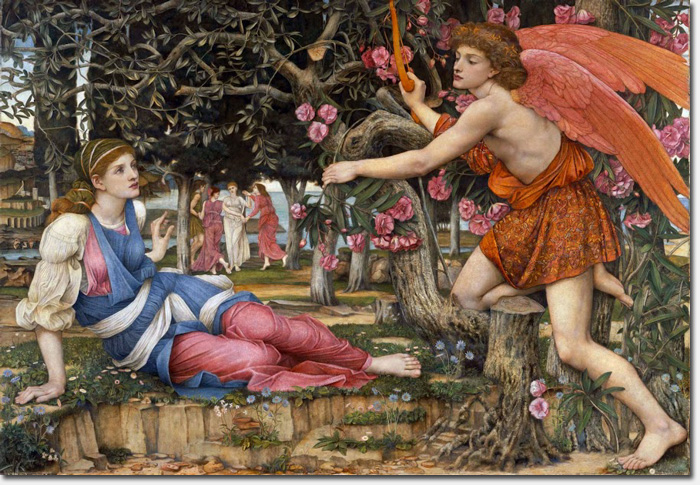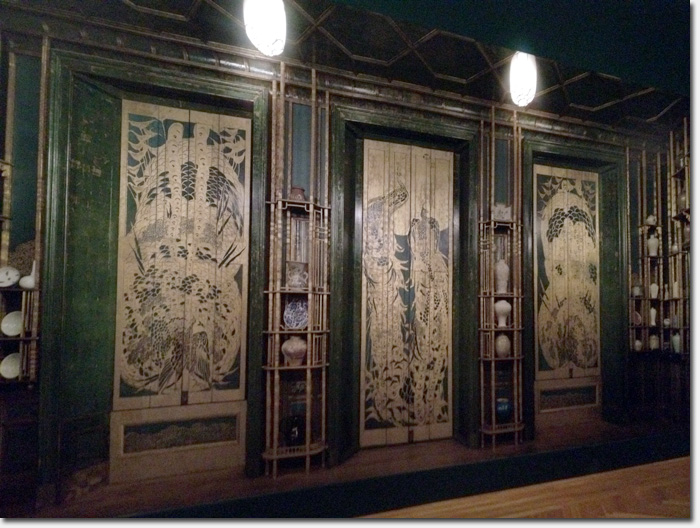
John Spencer Stanhope, Love and the Maiden, 1877
It took museum curator Dr. Lynn Federle Orr nearly ten years to pull together the “Cult of Beauty: The Victorian Avant-Garde, 1860–1900” exhibition that opened last weekend at the Legion of Honor.
It’s no wonder – the show is a hand-picked, exquisite collection of 180 paintings, furnishings, textiles and other decorative pieces that represent the breadth of the British Aesthetic Movement.
 While Britain was in the midst of an Industrial Revolution, its artists and designers began a movement in aesthetic beauty, aimed at redefining the relationship between art, the artist and everyday society. Why should beautiful things and artistry be confined to museum and gallery walls? The movement’s rallying cry of “Art for Art’s Sake” was avant-garde in and of itself.
While Britain was in the midst of an Industrial Revolution, its artists and designers began a movement in aesthetic beauty, aimed at redefining the relationship between art, the artist and everyday society. Why should beautiful things and artistry be confined to museum and gallery walls? The movement’s rallying cry of “Art for Art’s Sake” was avant-garde in and of itself.
“Cult of Beauty: The Victorian Avant-Garde, 1860–1900” showcases many different types of art from the period, featuring artists like Dante Gabriel Rossetti, William Morris, Thomas Jeckyll and American ex-pat James McNeill Whistler.
One section of the show is dedicated to London’s influential Grosvenor Gallery, founded in 1877 and heralded for housing work by artists – like Whistler, Rossetti and Edward Burne-Jones – who were shunned by the more classical and conservative Royal Academy.
The artists of the period were multi-faceted, more like designers that worked in painting one day, home decor the next. While Whistler is best known for his paintings, the exhibition highlights his other contributions to the movement.
Spotlighted in the show is a replica of Whistler’s decadent, yet tastefully elegant “Peacock Room”, which he designed for a client in 1908. The “re-construction” of the room for the show is innovative – created entirely from one-dimensional, lifesize photographs that line the walls. Akin to walking into a three dimensional picture of the room (Whistler’s original “Peacock Room” is housed in the Freer Gallery of Art at the Smithsonian – view a panorama).

Whistler’s “Peacock Room” is recreated using photographic overlays on the walls
The show also displays some beautiful wallpapers, which are representative of the emerging trend in home decor of the period. Artists created rich wallpapers and furnishings to decorate their own living spaces, inspiring a trend towards House Beautiful, showcased in the “Aesthetic Houses for Beautiful People, 1870s–1880s” section of the show.
Home decor became more affordable and accessible during the period, driving commercial manufacturers to market signature wallpapers, fabrics and other decorator items at affordable price points. Suddenly, beauty within one’s own home was achievable by more than just the wealthy upper class.
Curator Dr. Lynn Federle Orr describes the movement well in her essay in the exhibition’s catalogue, writing, “Like a fine Victorian novel, the story of the Aesthetic Movement is one centered around serious social debates—shifting class structures, the confrontation between science and religion, art’s place in society, the impact of new market forces and a unique emphasis on the middle-class home.”
A later room in the show, entitled “Late-Flowering Beauty: 1880s–1890s”, displays rich paintings and sculptures from artists of the period like Rosetti, alongside examples of fine book design and poetry.
In contrast to the austere, cold and sometimes harsh representations we often encounter in Victorian era culture, the “Cult of Beauty” highlights the opposing forces and colors that shone through during the Aesthetic movement. Soft blues, colorful peacocks, rich blues, reds and golds – these are the colors of the art from this avant-garde period that opened the doors for later movements like Art Nouveau.
What’s unique about the “Cult of Beauty” show is that it showcases a movement that rarely is given its own exhibition. Normally you’d see these pieces are parts of other exhibitions dedicated to single mediums or decorative arts. But here is assembled the beauty of the British Aesthetic Movement in its entirety – from modern tea sets to home decor, to richly expressive paintings and sculptures. Art for art’s sake, and it couldn’t be more beautiful.
The Legion of Honor is the sole U.S. venue for the “Cult of Beauty: The Victorian Avant-Garde, 1860–1900” exhibition, which runs until June 17.
Sarah B.

Edward William Godwin, Sideboard, 1865–75

Sir Lawrence Alma-Tadema, Chair, ca. 1884-6
It looks like an amazing show. Would love to see it come to Vancouver
The review spurs me on to see the show. Looks like it is all encompassing…a little something for everyone. Thanks.
It looks amazing, defiantly going out to check it out. Thank you